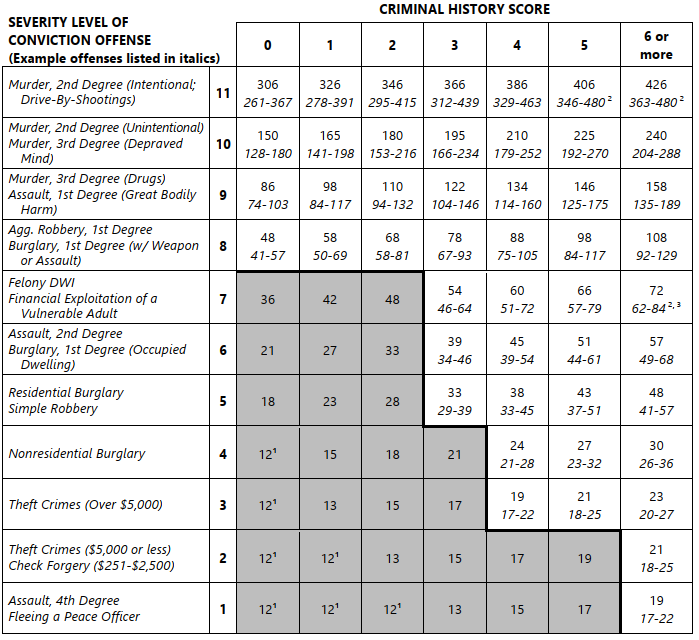Criminal sentencing in Minnesota works very differently for felony charges versus misdemeanor or gross misdemeanor cases. Generally speaking, judges have very wide latitude to do whatever they think is appropriate when sentencing misdemeanor or gross misdemeanor cases. Some offenses have mandatory minimums or other requirements, but generally the judge has a lot of freedom. However, with felony cases the judge’s hands are much more tied.
Felony sentences are governed by the Minnesota Sentencing Guidelines. You can view this document here if you’d like. The purpose of the guidelines is to “establish rational and consistent sentencing standards that promote public safety, reduce sentencing disparity, and ensure that the sanctions imposed for felony convictions are proportional to the severity of the conviction offense and the offender’s criminal history.” Basically, the goal is to ensure that people with similar criminal histories that commit similar offenses should receive similar sentences.
When sentencing someone on a felony case, that person’s criminal history score is calculated via a complicated formula. Each felony offense also has an assigned number, known as a “severity level.” The judge takes the severity level of the offense being sentenced, along with the person’s criminal history score, and consults a chart that will show what the sentence should be. This is called the “presumptive sentence.” The chart looks like this:

An important thing to note is the think black line that separates the top and right sides of the chart from the shaded boxes on the bottom and left sides. Any sentence that falls in the shaded section is presumed to be a probationary sentence, and a sentence that falls outside the shaded section is presumed to be a prison sentence. Note also that each box has a number or range of numbers. Those numbers are the number of months that the person should be sentenced to. For prison commit cases (the unshaded portion of the chart), the judge can sentence a person to any number of months within the ranges provided. Those boxes containing ranges also contain a single number that is considered to be the “normal” sentence for that box.
Just because a person receives a probationary sentence under the guidelines does not mean that they will not do any jail time. A judge giving someone a probationary sentence is still free to order them to serve jail time in a local jail as part of their sentence, but it cannot be more than 1 year.
In a future post, I’ll take a look at “departures”, or when a judge gives a sentence that varies from that called for by the sentencing grid. Departures are a major part of felony cases and are complex enough to call for a post of their own.


